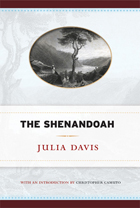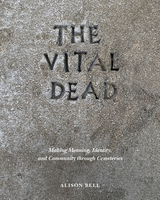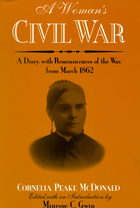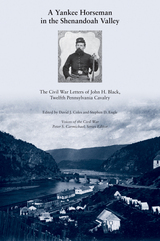


What can a cemetery tell us about the social and cultural dynamics of a place and time? Anthropologist Alison Bell suggests that cemeteries participate in the grassroots cultural work of crafting social connections, even as they test the transcendental durability of the deceased person and provide a measure of a culture’s values. In The Vital Dead, Bell applies this framework to the communities of Virginia’s Shenandoah Valley and the cemeteries that have both claimed them and, paradoxically, sustained them.
Bell surveys objects left on graves, images and epitaphs on grave markers, and other artifacts of material culture to suggest a landscape of symbols maintaining relationships across the threshold of death. She explores cemetery practice and its transformation over time and largely presents her interpretations as a struggle against alienation. Rich in evocative examples both contemporary and historical, Bell’s analysis stems from fieldwork interviews, archival sources, and recent anthropological theory. The book’s chapters range across cemetery types, focusing on African American burials, the grave sites of institutionalized individuals, and modern community memorials. Ultimately, The Vital Dead is an account of how lives, both famous and forgotten, become transformed and energized through the communities and things they leave behind to produce profound and unexpected narratives of mortality. Bell’s deft storytelling coupled with skill for scholarly analysis make for a fascinating and emotionally moving read.
Groundbreaking in its approach, The Vital Dead makes important contributions to cemetery and material culture studies, as well as the fields of anthropology, archaeology, history, geography, and folklore.

McDonald’s story of the Civil War records a personal and distinctly female battle of her own—a southern woman’s lonely struggle in the midst of chaos to provide safety and shelter for herself and her children. For McDonald, history is what happens “inside the house.” She relates the trauma that occurs when the safety of the home is disrupted and destroyed by the forces of war—when women and children are put out of their houses and have nowhere to go.
Whether she is describing a Union soldier’s theft of her Christmas cakes, the discovery of a human foot in her garden, or the death of her baby daughter, McDonald’s story of the Civil War at home is compelling and disturbing. Her tremendous determination and unyielding spirit in the face of the final collapse of her world is testimony to a woman’s will to preserve her family and her own sense of purpose as a “rebel” against all that she regarded as tyrannical and brutal in war itself.

In many ways, John H. Black typified the thousands of volunteers who fought for the Union during the Civil War. Born in 1834 and raised on his family’s farm near Allegheny Township, Pennsylvania, Black taught school until he, like many Pennsylvanians, rushed to defend the Union after the attack on Fort Sumter in April 1861. He served with the Twelfth Pennsylvania Cavalry, one of the Union’s most unruly, maligned, and criticized units.Consistently outperformed early in the conflict, the Twelfth finally managed to salvage much of its reputation by the end of the war. Throughout his service, Black penned frequent and descriptive letters to his fiancée and later wife, Jennie Leighty Black. This welcome volume presents this complete correspondence for the first time, offering a surprisingly full record of the cavalryman’s service from 1862 to 1865 and an intimate portrait of a wartime romance.
In his letters, Black reveals his impassioned devotion to the cause, frequently expressing his disgust toward those who would not enlist and his frustration with friends who were not appropriately patriotic. Despite the Twelfth Pennsylvania’s somewhat checkered history, Black consistently praises both the regiment’s men and their service and demonstrates a strong camaraderie with his fellow soldiers. He offers detailed descriptions of the regiment’s vital operations in protecting Unionists and tracking down and combating guerrillas, in particular John Singleton Mosby and his partisan rangers, providing a rare first-person account of Union counterinsurgency tactics in the Lower Shenandoah Valley. In the midst of portraying heated and chaotic military operations, Black makes Jennie a prominent character in his war, illustrating the various ways in which the conflict altered or nurtured romantic relationships.
One of the few compilations of letters by a long-term Yankee cavalry member and the only such collection by a member of the Twelfth Pennsylvania, A Yankee Horseman in the Shenandoah Valley provides new insights into the brutal, confused guerrilla fighting that occurred in northwestern Virginia. Moreover, these letters make a significant contribution toward an emerging consensus that Yankee cavalry—often maligned and contrasted with their celebrated Confederate foes—became a superior fighting force as the war progressed.
David J. Coles, professor of history at Longwood University, is the associate editor of the Encyclopedia of Civil War, coauthor of Sons of Garibaldi in Blue and Gray, and coeditor of the Encyclopedia of the American Civil War.
Stephen D. Engle, professor of history at Florida Atlantic University, is the author of Yankee Dutchman: The Life of Franz Sigel, Don Carlos Buell: Most Promising of All, and Struggle for the Heartland: The Campaigns from Fort Henry to Corinth.
READERS
Browse our collection.
PUBLISHERS
See BiblioVault's publisher services.
STUDENT SERVICES
Files for college accessibility offices.
UChicago Accessibility Resources
home | accessibility | search | about | contact us
BiblioVault ® 2001 - 2024
The University of Chicago Press









